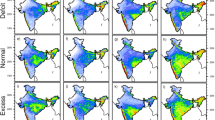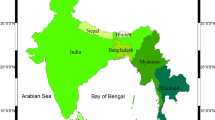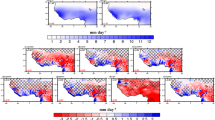Abstract
Multiyear (1983–2006) hindcast simulation of summer monsoon over South Asia has been carried out using the regional climate model of the Beijing Climate Centre (BCC_RegCM1.0). The regional climate model (hereafter BCC RCM) is nested into the global climate model of the Beijing Climate Centre BCC_CGCM1.0 (here after CGCM). The regional climate model is initialized on 01 May and integrated up to the end of the September for 24 years. Compared to the driving CGCM the BCC RCM reproduces reasonably well the intensity and magnitude of the large-scale features associated with the South Asia summer monsoon such as the upper level anticyclone at 200 hPa, the mid-tropospheric warming over the Tibetan plateau, the surface heat low and the 850 hPa moisture transport from ocean to the land. Both models, i.e., BCC RCM and the driving CGCM overestimates (underestimates) the 850 hPa southwesterly flow over the northern (southern) Arabian Sea. Moreover, both models overestimate the seasonal mean precipitation over much of the South Asia region compared to the observations. However, the precipitation biases are significantly reduced in the BCC RCM simulations. Furthermore, both models simulate reasonably the interannual variability of the summer monsoon over India. The precipitation index simulated by BCC RCM shows significant correlation (0.62) with the observed one. The BCC RCM simulates reasonably well the spatial and temporal variation of the precipitation and surface air temperature compared to the driving CGCM. Further, the temperature biases are significantly reduced (1–4°C) in the BCC RCM simulations. The simulated vertical structure of the atmosphere show biases above the four sub-regions, however, these biases are significantly reduced in the BCC RCM simulations compared to the driving CGCM. Compared to the driving CGCM, the evolution processes of the onset of summer monsoon, e.g., the meridional temperature gradient and the vertical wind shear are well simulated by the BCC RCM. The 24-year simulations also show that with a little exception the BCC RCM is capable to reproduce the monsoon active and break phases and the intraseasonal precipitation variation over the Indian subcontinent.











Similar content being viewed by others
References
Antic S, Laprise R, Denis B, de Elia R (2006) Testing the downscaling ability of a one-way nested regional climate model in regions of complex topography. Clim Dynamics 26:305–325. doi:10.1007/s00382-005-0046-z
Ashfaq M, Shi M, Ww T, Trapp RJ, Gao X, Pal JS, Diffenbarugh NS (2009) Supression of south Asian summer monsoon in the 21st century. Geophys Res Lett 36:L01704. doi:10.1029/2008GL036500
Bansod SD, Singh SV (1995) Pre-monsoon surface pressure and summer monsoon rainfall over India. Theo Appl Climatol 5:59–66
Bhaskar Rao DV, Ashok K, Yamagata T (2004) A numerical simulation study of the Indian summer monsoon of 1994 using NCAR MM5. J Meteoro Soc Japan 82:1755–1775
Bhaskaran B, Jones RG, Murphy JM, Noguer M (1996) Simulation of Indian summer monsoon using a nested regional climate model: Domain size experiments. Climate Dyn 12:573–587
Bhowmik SK, Parsad K (2001) Some characteristics of limited area model precipitation forecast of Indian monsoon and evaluation of associated flow features. Meteor Atmos Phys 76:223–236
Bhowmik SK, Joardar D, Hatwar HR (2007) Evaluation of precipitaion prediction skill of IMD operational NWP system over Indian monsoon region. Meteor Atmos Phys 95:205–221
Chan JCL, Liu Y, Chow KC, Ding Y, William KML, Chan KL (2004) Design of a regional climate model for the simulation of south China summer monsoon rainfall. J Meteor Soc Japan 82:1645–1665
Das S, Mitra AK, Iyengar GR, Mohandas S (2001) Comprehensive test of different cumulus parameterization schemes for simulation of Indian summer monsoon. Meteorol Atmos Phys 78:227–244
Dash SK, Shekhar MS, Singh GP (2006) Simulation of Indian summer monsoon circulation and rainfall using RegCM3. Theor Appl Climatol 86:161–172
Dhar ON, Nandargi S (2003) Hydrometeorological aspects of floods in India. Nat Hazards 28:1–33
Ding Y, Liu Y, Song Y, Li Q (2002) Research and experiments of a short term climate dynamic prediction model in China. Clim Environ Res 7:236–246
Ding Y et al (2004a) Advance in seasonal dynamical prediction operation in China. Acta Meteorlogica Sinica 62:598–612
Ding Y, Shi X, Sun Y, Liu Y (2004b) Simulations and predictions for flooding season in china by using a nested regional climate model. Chinese J Atmos Sci 28:205–217
Ding Y, Shi X, Liu Y, Liu Y, Li Q, Qian Y, Miao M, Zhai G, Gao K (2006a) Multiyear simulations and experimental seasonal predictions for rainy seasons in China by using a nested Regional Climate Model (RegCM_NCC). Part I: sensitivity study. Adv Atmos Sci 23:323–341
Ding Y, Liu Y, Shi X, Li Q, Li Q, Liu Y (2006b) Multiyear simulations and experimental seasonal predictions for rainy seasons in China by using a nested Regional Climate Model (RegCM_NCC). Part II: the experimental seasonal prediction. Adv Atmos Sci 23:487–503
Flohn H (1957) Large-scale aspects of the summer monsoon in South and East Asia. J Meteor Soc Japan 75:180–186
Gadgil S, Vinayachandran PN, Francis PA (2003) Droughts of the Indian summer monsoon: Role of the clouds over the Indian Ocean. Curr Sci 85:1713–1719
Giorgi F, Hewitson J (2001) Regional climate information-evaluation and projection. In: Haughton B (ed) Climate change 2001: the scientific basis. Cambridge University Press, Cambridge, UK, pp 585–638
Giorgi F, Shields C (1999) Tests of precipitation parameterizations available in the latest version of NCAR regional climate model (RegCM) over continental U.S. J Geophys Res 104:6353–6376
Giorgi F, Marinucci MR, Canio GD, Bates GT (1993a) Development of a second generation regional climate model (RegCM2), Part I: boundary layer and radiative processes. Mon Wea Rev 121:2794–2813
Giorgi F, Marinucci MR, Bates GT (1993b) Development of a second generation regional climate model (RegCM2), Part II: Convective processes and assimilation of lateral boundary conditions. Mon Wea Rev 121:2814–2832
Goddard L, Mason SJ, Zeibiak SE, Ropelewski CF, Basher R, Cane MA (2001) Current approaches to seasonal to interannual climate predictions. Int J Climatol 21:1111–1152
Goswami BN, Xavier PK (2005) ENSO control on the South Asian monsoon through the length of the rainy season. Geophy Res Letter 32:L18717. doi:10.1029/2005GL023216
Goswami BN et al (1999) A broad scale circulation index for the interannual variability of the Indian summer monsoon. Q j R Meteorol Soc 125:611–633
Haln DG, Manabe S (1995) The role of mountains in the South Asian Monsoon Climate. J Atmos Sci 32:1515–1541
He M, McGinnis JW, Song Z, Yanai M (1987) Onset of Asian Summer monsoon in 1979 and effects of Tibetan Plateau. Mon Wea Rev 115:1966–1995
Hewitt CN, Jackson A (2003) Hand book of the atmospheric science: principles and applications. Blackwell, pp 81
Hoskins B, Wang B (2006) Large-scale atmospheric dynamics. In: Wang B (ed.) The Asian Monsoon. Springer-Praxis, pp 357–415
Jiang X, Li T, Wang B (2004) structures and mechanisms of the northward propagation of boreal summer intraseasonal oscillations. J Climate 17:1022–1039
Jin X, Zhang X, Zhou T (1999) Fundamental framework and experiments of third generation of IAP/LAGS World Ocean General Circulation Model. Adv Atmos Sci 16:197–215
Kalnay E et al (1996) The NCEP/NCAR 40-year reanalysis project. Bull Amer Meteor Soc 77:437–470
Koteswaram P (1958) The easterly jet stream in the tropics. Tellus 10(43):56
Krishna Kumar K, Rupa KK, Ashrit RG, Deshpande NR, Hansen JW (2004) Climate impacts on Indian agriculture. Int J Climatol 24:1375–1393
Krishnamurti TN (1973) Tibetan high and upper tropospheric tropical circulation during northern summer. Bull Amer Meteor Soc 54:1234–1249
Lee DK, Suh MS (2000) Ten-year east Asian summer monsoon simulation using a regional climate model (RegCM2). J Geophy Res 105:29565–29557
Legates DR, Willmott CJ (1990a) Mean seasonal and spatial variability global surface air temperature. Theor Appl Climatol 41:11–21
Legates DR, Willmott CJ (1990b) Mean seasonal and spatial variability in gauge-corrected, global precipitation. Int J Climatol 10:111–127
Li CF, Yanai M (1996) Atmospheric circulation characteristics associated with the onset of Asian summer monsoon. Adv Atmos Sci 23:925–939
Liu Y, Ding Y (2002a) Modified mass flux cumulus convective parameterization scheme and its simulation experiments—part I: mass flux scheme and its simulation of 1991 flood event. Acta Meteorologica Sinica 16:37–49
Liu Y, Ding Y (2002b) Simulation of heavy rainfall in the summer of 1998 over China with regional climate model. Acta Meteorologica Sinica 16:346–362
Liu Y, Chan JCL, Chow KC, Ding Y (2006) Ten-year climatology of summer monsoon over South China and its surroundings simulated from a regional climate model. Int J Climatol 26:147–157
Liu Y, Hoskins BJ, Blackburn M (2007) Impact of Tibetan orography and heating on the summer flow over Asia. J Meteor Soc Japan 85B:1–19
Mearns L, Giorgi F, Whetton P, Pabon D, Hulme M, and Lal M (2003) Guidelines for use of climate scenarios developed from regional climate model experiments. The 5th IPCC/TGCIA Meeting, Barbados, 38pp
Nicolini M, Salio P, Katzfey JJ, McGregor JL, Saulo AC (2002) January and July regional climate simulation over South America. J Geophys Res 107:D22, 4637
Oliver JE (2005) Encyclopedia of the world climatology. Springer, ISBN-978-1-4020-3264-6, pp 119
Pan Z, Christensen JH, Arritt RW, Gutowski J, Takle ES, Otieno F (2001) Evaluation of uncertainties in regional climate change simulations. J Geophys Res 106:17735–17751
Parthasarathy B et al (1992) Indian summer monsoon rainfall indexes 1871–1990. Meteorol Mag 121:174–186
Rajeevan M, Gadgil S, Bhate I (2008) Active and break spells of Indian summer monsoon. NCC research report, NCC7, National Climate Centre, Indian Meteorological Department, Pune-411005
Ramage CS (1965) The summer atmospheric circulation over the Arabian Sea. J Atmos Sci 23:144–150
Ramamurthy K (1969) Some aspects of the break in the Indian southwest monsoon during July and August. Forecasting Mannual Report No. IV-18.3, Indian Meteorological Department, New Delhi, India
Soman M, KrishnaKumar K (1993) Space time evolution of meteorological features associated with the onset of Indian summer monsoon. Mon Weath Rev 121:1177–1194
Sperber KR et al (2001) Dynamical seasonal predictability of the Asian summer monsoon. Mon Wea Rev 129:2226–2248
Yani M, Wu GX (2006) Effects of Tibetan plateau. In: Wang B (ed.) The Asian –Monsoon. Springer-Praxis, pp 513–549
Zhong Z, Yinjia H, Jinzhong M, Honglei X (2007) Numerical experiments on the spin-up time for seasonal-scale regional climate modeling. Acta Meteorologica Sinica 21:409–419
Acknowledgments
The author would like to express sincere thanks to the Beijing Climate Centre (BCC) for providing funding to visit and work in BCC particularly on the above issue of seasonal prediction over south Asia region. The authors are also very much thankful to Dr. Wolfgang Müller from Max Planck Institute for Meteorology for his suggestions on the first draft of the manuscript. Finally, the authors are grateful to the esteemed reviewers for their worthy comments and suggestions which immensely helped in improving this paper.
Author information
Authors and Affiliations
Corresponding author
Rights and permissions
About this article
Cite this article
Saeed, S., Liu, Y. & Rasul, G. Multiyear hindcast simulations of summer monsoon over South Asia using a nested regional climate model—BCC_RegCM1.0. Theor Appl Climatol 103, 249–264 (2011). https://doi.org/10.1007/s00704-010-0297-4
Received:
Accepted:
Published:
Issue Date:
DOI: https://doi.org/10.1007/s00704-010-0297-4




